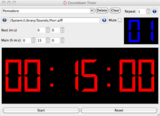
Countdown Timer
Countdown Timer counts down a specified time and sounds an alarm.
I wanted a timer with a repeat feature to help time my circuit training. I realised it would be useful to be able to time other regular events like waiting for coffee to brew or the 7 second stretch reflex. To make it easy to recall the settings, profiles can be created and edited.
Recent Changes
Version 2.5
- Overrun : if overrun is selected countdown will start counting up when time has expired
- Linux AppImage for x86
Version 2.4
- Built for Windows
- If you change the main timer when the counter is in progress (running or paused) the countdown will not be affected until the next repeat or reset
Features
- Large counter display
- Rest timer
- Repeat
- Alarm by WAVE files or buzzer (Zaurus)
- Editable profiles
- Automatic wake up from stand by mode (Zaurus)
Screenshots

Version 2.5
Older Screenshots
Download
| File | Version | Platform | Size | MD5 |
|---|---|---|---|---|
| CountdownTimer-2.5-x86_64.AppImage | 2.5 | Linux | 35 MB | 5998cd50a8bf0a2412d7181907fc1a10 |
| CountdownTimer-2.5.dmg | 2.5 | Mac | 9.6 MB | 929e8c1c2a31078920740fd6df063d7e |
| CountdownTimer-2.5-win.zip | 2.5 | Windows | 20 MB | ab071e799ad708423b4679d2de9d354a |
| countdowntimer_2.5_arm.ipk | 2.5 | Zaurus | 40 KB | b2f72e8eb3969fc3d7af7873b069b6bb |
| Wilhelm.wav | n/a | Any | 89 KB |
On Linux x86, copy the AppImage file to any directory of your choice, rename it to CountdownTimer and chmod a+x CountdownTimer. AppImages are distribution agnostic.
On Mac, Countdown Timer should run on OS X 10.7 and above. It should be able to play back any sample that QuickTime can play.
On Windows, you will encounter a warning that the software is not trusted because it is not digitally signed - ignore this. Right click on the zip file and select "Uncompress to CountdownTimer-X.Y-win". You can move this folder to somewhere convenient on your disk. Now select CountdownTimer.exe, right click and create a shortcut. You can move this shortcut to your desktop. Now you need to find some suitable wav files.
On Zaurus, Countdown Timer can play back uncompressed PCM WAVE files, mono or stereo. You can find a handy zip file with alarm sounds here. On most Linux/BSD systems you can check if a WAVE file is in the right format:
$ file Wilhelm.wav Wilhelm.wav: RIFF (little-endian) data, WAVE audio, Microsoft PCM, 16 bit, mono 48000 Hz
If it says Microsoft PCM then the WAVE file should be compatible. Windows seems to prefer 16 bit files.
I found the Wilhelm scream online and converted it using audacity. This is a great sound to use for alarms.
Tip
To add a profile,
- Select the profile most similar to the one you wish to create
- Click/tap on the profile selector
- Edit the name to the new profile name and press enter
- You are now editing the new profile
Acknowledgements
The main icon is Orologio Rosso, taken from Wikimedia Commons. The small icons used in the GUI are from the Crystal set by Everaldo.









